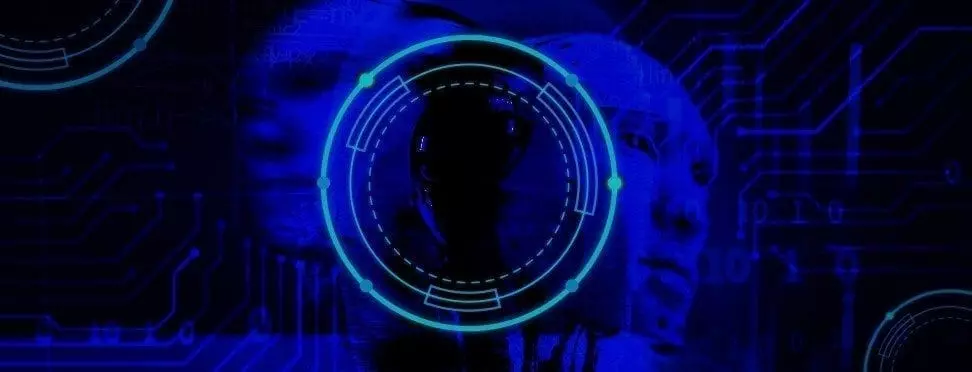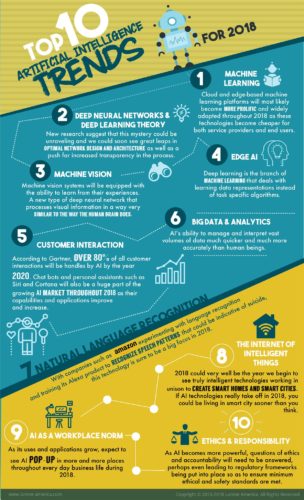
AI technologies are some of the most complex and exciting topics going into the new year. We’ve put together our list of the top 10 Artificial Intelligence trends to look out for in 2018.
1-Machine Learning
Machine learning (ML) is the branch of artificial intelligence that focuses on equipping machines with the ability to learn without human intervention or programming. Various kinds of machine learning platforms are currently available for businesses and enterprises to begin to take advantage of AI. Different approaches to machine learning will most likely be common throughout 2018 as hybrid and deep learning models are combined so as to account for and model uncertainty. Cloud and edge-based machine learning platforms will also most likely become more prolific and widely adopted throughout 2018 as these technologies become cheaper for both service providers and end users.
2-Deep Neural Networks & Deep Learning Theory
Deep neural networks (DNNs) are artificial neural networks that contain multiple hidden layers between their input and output layers, occasionally referred to as “stacked” neural networks. Deep learning is the branch of machine learning that deals with learning data representations instead of task specific algorithms. Despite their being in use for a while now, DNNs and deep learning theory have remained largely a mystery to experts. However, new research suggest that this mystery could be unraveling and we could soon see great leaps in optimal network design and architecture as well as a push for increased transparency in the process.
3-Machine Vision
Already this year there have been some impressive advances in machine vision systems in industries such as manufacturing, agriculture, and energy and utilities. With artificial intelligence, machine vision systems will be equipped with the ability to learn from their experiences. One of the most exciting areas of machine vision and AI is that of capsule networks, a new type of deep neural network that processes visual information a way very similar to the way the human brain does, allowing them to maintain hierarchical relationships. It is estimated that this could improve the accuracy of image identification tasks by as much as 50%, while also needing less data for training models.
4-Edge AI
One of the most interesting differences between human brains and artificial intelligence tools is the location the “processing” takes place. With AI, the majority of processing and analysis is done in cloud servers rather than on edge devices due to the large data and computing power they require. In humans, however, these functions take place within the brains themselves, at the edge. One of the ways in which AI is being brought to edge devices is through AI co-processors which are capable of running machine learning algorithms on-device or through portable dongles such as the USB-3 deep learning compute stick from Movidius.
5-Customer Interaction
Using artificial intelligence for customer interaction has already become one of the most popular applications for AI and ML technologies and this trend is likely to continue into 2018 with more products and potential applications becoming available over time. According to Gartner, over 80% of all customer interactions will be handles by an AI by the year 2020. Chat bots and personal assistants such as Siri and Cortana will also be a huge part of the growing AI market throughout 2018 as their capabilities and applications improve and increase.
Infographic
Share this Image on your site
6-Big Data & Analytics
AI’s ability to manage and interpret vast volumes of data much quicker and much more accurately than human beings is what sets it aside as a potentially revolutionary technology. With the continuing growth of the Internet of Things will come an enormous increase in the amount of data that is collected an ever-increasing number of connected devices as well as the need for a way to process and analyze this data. Artificial intelligence and machine learning technologies will become more essential than ever in enabling data to be interpreted into actionable and meaning insights that can be learnt from without the need for human intervention.
7-Natural Language Recognition
One of the biggest challenges for artificial intelligence technologies has been interpreting intent from the natural language human beings use. Anyone that’s ever experienced an automated call assistant that can’t quite understand what you’re saying will understand the frustrating shortcomings of conversational AI. However, this inadequacy could all be about to change and the implications of improved conversational AI are far reaching. With companies such as Amazon experimenting with language recognition and training its Alexa product to recognize speech patterns that could be indicative of suicide, this technology is sure to be a big focus in 2018.
8-The Internet of Intelligent Things
In order to truly realize the concept of a smart city, IoT devices will need to be intelligent enough to operate and maintain themselves without the need for human intervention. The widespread adoption of AI technologies alongside the continuing expansion of the Internet of Things will begin to build upon the technological foundations laid by previous associated technologies. 2018 could very well be the year we begin to see truly intelligent technologies working in unison to create smart homes and smart cities. If AI technologies really take off in 2018, you could be living in smart city sooner than you think.
9-AI as a Workplace Norm
There are already a large number of businesses and enterprises within a huge variety of industries around the world that are now turning to artificial intelligence and machine learning technologies to perform a myriad of different roles and applications within the workplace. With a growing product base and many more innovations lingering on the horizon, 2018 could also be the year artificial intelligence becomes an everyday technology for a large number of businesses and organizations. As its uses and applications grow, expect to see AI pop in more and more places throughout every day and business life during 2018.
10-Ethics & Responsibility
Ethics and responsibility are often only briefly mentioned within a discussion on workplace applications of artificial intelligence. However, as the computational power and responsibilities given to AI grow, more attention will need to be given to the ethical considerations of artificial intelligence. Who is responsible for a workplace accident where an AI is purely doing what it has told itself to do, is the company or the AI itself accountable? As AI becomes more powerful, questions of ethics and accountability will need to be answered, perhaps even leading to regulatory frameworks being put into place so as to ensure minimum ethical and safety standards are met.







